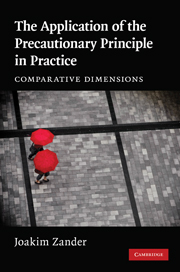Book contents
- Frontmatter
- Contents
- Acknowledgements
- Abbreviations
- Table of Cases
- Table of Legislation
- EU Legislation and Soft Law
- Swedish Legislation, preparatory work, etc.
- United Kingdom
- United States of America
- 1 Introduction
- 2 Risk and uncertainty: basic concepts and tools for the application of the precautionary principle
- 3 The precautionary principle in international law
- 4 The precautionary principle in EU law
- 5 The precautionary principle in Sweden
- 6 The precautionary principle in the United Kingdom
- 7 The precautionary principle in the United States
- 8 Conclusions
- Bibliography
- Index
2 - Risk and uncertainty: basic concepts and tools for the application of the precautionary principle
Published online by Cambridge University Press: 17 November 2010
- Frontmatter
- Contents
- Acknowledgements
- Abbreviations
- Table of Cases
- Table of Legislation
- EU Legislation and Soft Law
- Swedish Legislation, preparatory work, etc.
- United Kingdom
- United States of America
- 1 Introduction
- 2 Risk and uncertainty: basic concepts and tools for the application of the precautionary principle
- 3 The precautionary principle in international law
- 4 The precautionary principle in EU law
- 5 The precautionary principle in Sweden
- 6 The precautionary principle in the United Kingdom
- 7 The precautionary principle in the United States
- 8 Conclusions
- Bibliography
- Index
Summary
Introduction
When Rachel Carson published her hugely influential book Silent Spring in 1962, she laid the foundation upon which the then recently conceived environmental movement would rest. With a language which is as dystopian as it is strangely poetic, Carson framed a rhetoric that would come to be much used by the environmental movement. Her fears and predictions with regard to chemicals, in particular dichloro-diphenyl-trichloroethane (DDT), still linger in the public minds of Europeans and Americans alike. Reports published over time maintaining that some of these fears are exaggerated have had nowhere near the same resonance as her original work.
Silent Spring was followed by other works in the 1970s which warned of the environmental consequences of industrialisation: Limits to Growth was published in 1972 and made the spectacular, and much publicised, claims that, by 1990, the world would have run out of gold, silver, mercury and zinc. In The End of Affluence, published in 1974, Paul and Anne Ehrlich predicted the dangers following global cooling and the near end of fish in the seven seas. Fortunately, none of these particular claims have materialised. However, in recent years publications have also emerged with the aim of highlighting the risks to human health and the environment that have actually materialised as a consequence of modernisation.
As a response to the above literature, some authors have also emphasised the lack of development and innovation that would have resulted had a certain amount of risks not been taken.
- Type
- Chapter
- Information
- The Application of the Precautionary Principle in PracticeComparative Dimensions, pp. 8 - 32Publisher: Cambridge University PressPrint publication year: 2010



